
A signal maintenance mechanic working on crossover points at Clyde rail yard, western Sydney, entered the danger zone before being struck by a passenger train and sustaining fatal injuries in the early morning of 18 June 2016.
A transport safety investigation into the accident, conducted on behalf of the Australian Transport Safety Bureau by NSW’s Office of Transport Safety Investigation (OTSI), determined that two signal maintenance team workers (a mechanic and an electrician) had assumed their worksite was within the protective limits of a Track Occupancy Authority (TOA) established for a civil maintenance team tasked to replace sleepers under the crossover at 64 points.
However, the protective limits of the TOA extended only to defined clearance points on either side of 64 points and did not include the 63B points, on the Up main line, where the signal maintenance team entered the danger zone.
The accident highlights the importance of planning and integrating safety across the entire scope of work.
“The investigation found that Sydney Train’s work-planning process, involving multiple work groups, did not assure the consideration of worksite safety for all tasks undertaken by each party over the duration of the work and when returning the rail infrastructure into service,” said OTSI Deputy Chief Executive Officer Kevin Kitchen.
The civil maintenance team’s Protection Officer (PO) was aware of the signal team’s work tasks but did not consider these in his worksite protection arrangements. The PO had not been briefed on the scope of the signal team’s work, and so did not provide protection at 63 points.
The investigation also identified that the network communications by various parties in Sydney Trains were not in accordance with the principles underpinning the network rules.
“This accident highlights the importance of planning and integrating safety across the entire scope of work,” said Mr Kitchen. “It also highlights the importance of briefing all workers, and of all workers seeking a safety briefing about the worksite protection plans before work commences and when circumstances change.”
Following the accident, Sydney Trains implemented a number of safety actions and delivered on safety commitments. These included requiring proposed worksite protection plans be reviewed and validated by Sydney Trains’ Corridor Safety Centre; appointing additional rail safety coaches and mentors, with a required coaching session for all Protection Officers at least once per year; and requiring Protection Officers implement a form of worksite protection at least once every quarter to remain eligible to be re-certified as a Protection Officer.
Additionally, Sydney Trains established a Post-Incident Assurance Group to respond to the accident. This Group established key focus areas to promote the safety of workers and avoid future incidents. These areas included worksite protection, culture, planning for maintenance work, and safety-critical communications.
The Group later established the Safety Focus Program, whose initiatives include safety focus sessions, a safety culture program, improvements to protection officer selection and training, a signal key switch project, safety-critical communication enterprise-wide program, and a maintenance access planning project.
Read the report: Track worker fatally injured when struck by train W510, Clyde, New South Wales, on 18 June 2016


